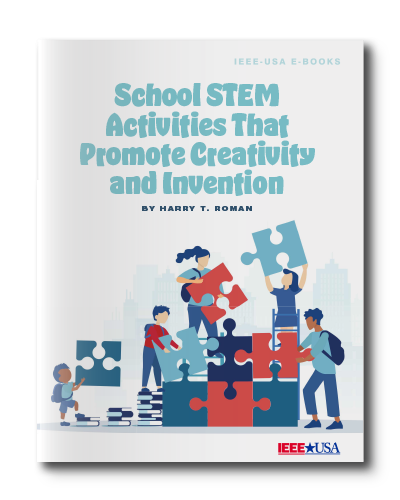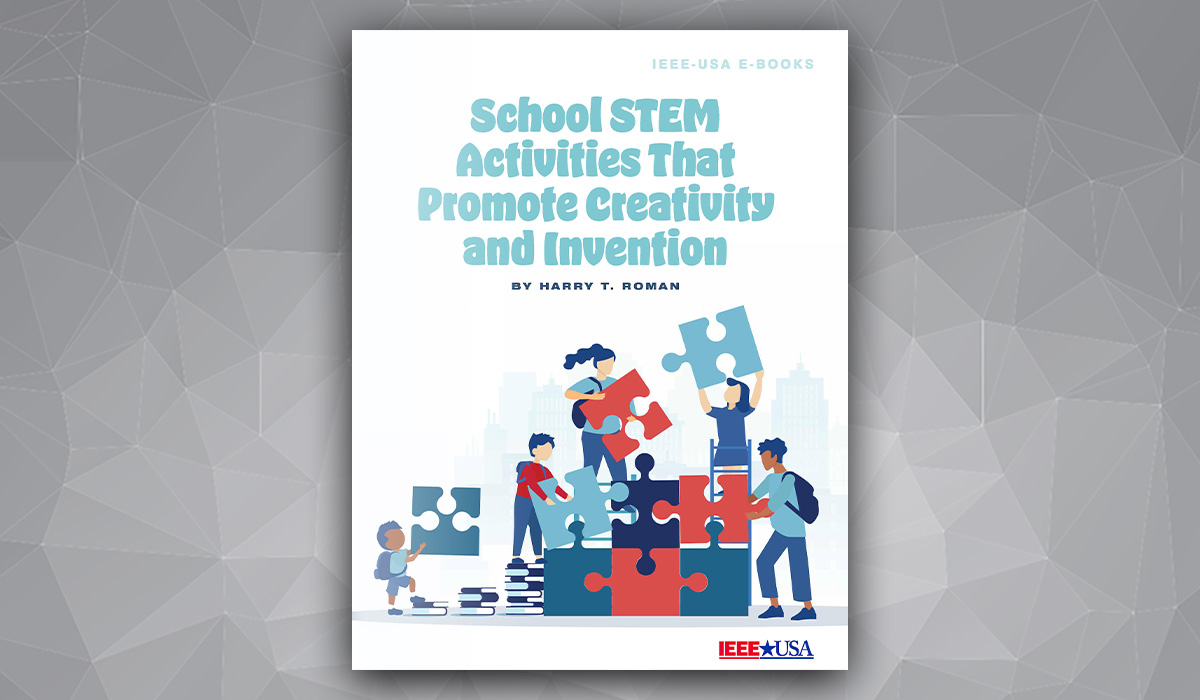
School STEM Activities That Promote Creativity and Invention
FREE to IEEE Members
Non-Members: $2.99
Harry T. Roman has written several books for teachers laying out creative ways to engage and stimulate students about STEM. In his new IEEE-USA book, School STEM Activities that Promote Creativity and Invention, Roman laser focuses the activities on the environments students know best — mainly their school, but also the communities where they live. He believes focusing on the school can “turn the creativity of students loose.” Roman also believes this approach can broaden students’ and teachers’ views on STEM and demonstrate how “the STEM philosophy of problem-solving can be quite far-reaching across technology and non-technology subject matters.”
The book is divided into four sections (Creativity and New Insights, Solar and Alternative Energy, Writing Activities, and Design Challenges), with each section packed full of classroom activities and exercises that stretch a student’s thinking — giving them insights into the engineering process. Roman offers a broad array of activities teachers and students can apply to many school settings, and that appeal to students with diverse interests.
Roman is a strong believer that these challenges should not be tackled by individual students but, whenever feasible, by teams. “Teamwork is important for upper grades — and later, college and the work-a-day world, where teamwork and project-based learning dominates.”
Given his several decades working in the energy field, it should be no surprise that Roman would recommend several activities relating to the way a student’s school might improve how they use (or generate) energy. These activities include:
- Evaluating putting solar panels over the parking lot; having the students evaluate the costs; estimating energy production; and determining best designs for the space.
- Investigating geothermal energy; identifying places where it is currently used in their community; and how it might be applied to the school.
However, the author’s suggested activities go way beyond energy, drawing on his extensive experiences teaching STEM in the classroom — from elementary age up to graduate school. Throughout the book he strives to make sure problems are relevant to the world around the students. Some of his suggestions include:
- Brainstorming and then evaluating credible ideas for changing the school day and the way subjects are taught to enable greater opportunities for creativity.
- Creating a math game for teaching elementary math concepts; and testing the games out in real classrooms; and having the students explore how to copywrite and possibly market the game.
- Exploring the history of the school, its architectural style, mascot, uniforms, flags, and histories. What changes would students recommend, and why?
- Looking into building a greenhouse at the school; identifying suitable locations; and evaluating whether plants could be economically grown to sel,l or to provide to the cafeteria.
- Evaluating alternative uses for the roof: could it, for instance, be used for a garden, relaxation space, or telescope platform?
- Investigating if the school were to close, how else might the building be used?
- Exploring, as a team, different ways indoor space could be less institutional– by incorporating water or garden elements; exploring what other schools have done; and surveying current students and staff.
- Proposing ways robots could be used to help clean; or provide enhanced security and safety at schools.
These are just some of the many ideas that Roman packs into his book. No matter the subject, he encourages teachers to ask, “What if?” questions; suggesting, “Asking questions is the cornerstone of all STEM activities and learning. Asking ’what if?’ questions super charges a student’s thinking — causing them to consider the ramifications of the questions — and its peripheral impacts on related areas.”
School STEM Activities that Promote Creativity and Invention is available for free for IEEE members at the IEEE-USA Store and for a nominal cost for non-members. While there, check out Roman’s other titles promoting STEM and creativity in the classroom.
Harry T. Roman has long been recognized as a STEM educator for his extensive writing and experience in classrooms. His recognitions include an IEEE Meritorious Achievement Award (1996) for developing continuing education products for IEEE members; a Distinguished Technology Educator Award from the New Jersey Technology Education and Engineering Association (1999); and IEEE’s Region 1 Excellence in Teaching award (2015).
Roman holds 12 U.S. patents from his 36 years in, or leading, PSE&G’s Research and Development group. Retired since 2006, he has published more than 70 resource books, math card games and science kits for teachers — with “head and hands” approach to teaching creativity, invention, STEM, engineering, and alternate energy topics. For the past three years, Roman has co-taught a course on applying STEM techniques in the classroom for graduate education students at Montclair State University.
